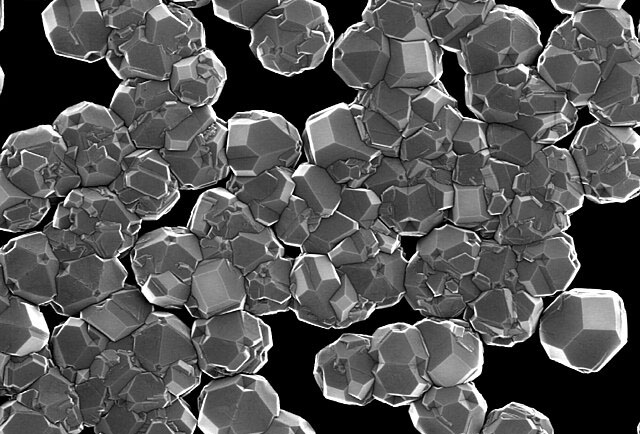Understanding Nanodiamonds – Their Structure, Properties, and Applications
Definition: Nanodiamonds, diamond particles that are a few nanometers in size, stand at the intersection of advanced materials science and nanotechnology. Due to their exceptional hardness, chemical stability, and unique optical properties, nanodiamonds are a focal point for research and application development across various fields, including electronics, medicine, and advanced coatings.

Advantages of Different Synthesis Methods
The synthesis of nanodiamonds can be achieved through several methods, each with distinct characteristics and implications for their use:
- Detonation Synthesis: This method involves the detonation of carbon-rich explosives in a contained environment, leading to the formation of nanodiamonds among other carbon forms. The key advantage of this technique is the production of ultra-small, pure diamond crystals at a relatively low cost, making it suitable for mass production. However, the nanodiamonds produced by detonation often require extensive purification.
- Chemical Vapor Deposition (CVD): Chemical Vapor Deposition growth of nanodiamonds occurs from a gas phase, where carbon-containing gases are decomposed at high temperatures in the presence of a substrate. This method allows for the controlled growth of nanodiamond films and particles, with the advantage of tailoring the diamond's properties by adjusting the process parameters. CVD is particularly useful for applications requiring specific crystal orientations or doping.
- High-Pressure High-Temperature (HPHT): HPHT mimics the natural formation conditions of diamonds, applying high pressure and temperature to carbon sources to produce nanodiamonds. This method can produce high-quality diamonds but is more energy-intensive and costly compared to other synthesis techniques. HPHT nanodiamonds are often used in applications where crystal quality is paramount.
Optical Properties of Nanodiamonds
Nanodiamonds exhibit unique optical properties, including a broad fluorescence spectrum and remarkable photostability, making them ideal candidates for fluorescent probes in biological imaging and as components in quantum technologies:
- Fluorescent Probes: Certain defects within nanodiamonds, such as nitrogen-vacancy (NV) centers, can fluoresce when exposed to light. This fluorescence is not only bright but also stable over time, unlike many organic dyes and quantum dots, which bleach under intense illumination. This makes nanodiamonds excellent candidates for long-term imaging applications in biological and material sciences.
- Quantum Technologies: The NV centers in nanodiamonds are also of great interest in quantum computing and quantum communications. Their ability to maintain quantum coherence at room temperature makes them a practical platform for quantum processing and secure quantum data transmission technologies.
Functionalization of Nanodiamonds
The surface of nanodiamonds can be functionalized with various chemical groups, significantly expanding their potential applications:
- Surface Groups: Hydroxyl, carboxyl, and amino groups are among the most common functional groups added to nanodiamond surfaces. This functionalization allows nanodiamonds to be more easily dispersed in solvents, attached to biomolecules, or bound to other materials, enhancing their compatibility and utility in composite materials, drug delivery systems, and biosensors.
- Applications: Functionalized nanodiamonds can be tailored for specific applications. For example, attaching therapeutic molecules to nanodiamonds allows for targeted drug delivery, while conjugation with specific antibodies can enable precise imaging and tracking of cellular processes.
Applications of Nanodiamonds
Nanodiamonds boast properties that make them valuable across fields—from medicine to industrial manufacturing. Here's a look at key areas where they're making an impact:
Biomedicine
- Drug Delivery: Nanodiamonds' biocompatibility and modifiable surface chemistry make them suitable carriers for targeted drug delivery. They can be loaded with therapeutic molecules and guided to specific tissues or cells.
- Bioimaging: Nanodiamonds with fluorescent defects can act as incredibly bright and stable markers for tracking biological processes within cells or living organisms.
- Tissue Engineering: Nanodiamonds can be incorporated into scaffolds to promote cell growth and tissue regeneration.
Electronics and Photonics
- Thermal Management: Nanodiamonds' high thermal conductivity allows them to efficiently dissipate heat in electronic devices, preventing overheating and improving performance.
- Electron Emitters: Nanodiamonds can be used to create field emission displays or emitters for other electronic applications.
Industrial and Mechanical Applications
- Lubricants and Additives: Adding nanodiamonds to lubricants significantly reduces friction and wear, extending the lifespan of machinery.
- Polishing Agents: Nanodiamonds' hardness makes them extremely effective for polishing a variety of materials with high precision.
- Composite Materials: Incorporation of nanodiamonds can enhance the strength, toughness, and wear resistance of polymers, ceramics, and other materials.
Environmental Applications
- Water Treatment: Nanodiamonds' large surface area and functionalizability are effective for adsorbing and removing pollutants from water.
- Sensors: Nanodiamond-based sensors can detect specific chemicals or environmental contaminants with high sensitivity.
The Future of Nanodiamond Applications
Ongoing research and development continue to push the boundaries of how we use nanodiamonds. Potential future applications include:
- Quantum Technologies: For quantum sensing, secure communication, and quantum computing.
- Targeted Cancer Therapies: Delivering drugs or generating localized heat to specifically destroy cancer cells.
- Advanced Coatings: Developing ultra-hard, wear-resistant, or self-lubricating coatings for various surfaces.
Note: This is not exhaustive. Nanodiamond research is an active field, so new applications are likely to emerge!
Nanodiamonds represent a versatile and promising class of nanomaterials, with their synthesis methods, optical properties, and functionalization techniques laying the groundwork for innovative applications in science and technology. Their ability to be synthesized through different methods allows for customization of their properties, catering to the needs of varied research and industrial applications.
The unique optical characteristics of nanodiamonds, especially their fluorescence and quantum properties, open up new avenues in bioimaging and quantum computing, while surface functionalization broadens their applicability in biomedicine and materials science. As research continues to unravel the full potential of nanodiamonds, their impact on technology and society is expected to grow significantly.
Further Reading
Nature Nanotechnology, The properties and applications of nanodiamonds
Nanotechnology, Biomedical applications of nanodiamond
Expert Opinion on Drug Delivery, A review of recent advances in nanodiamond-mediated drug delivery in cancer
